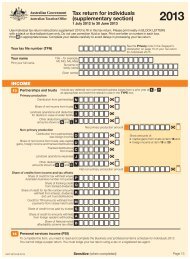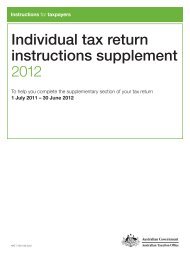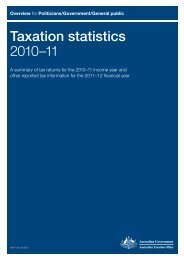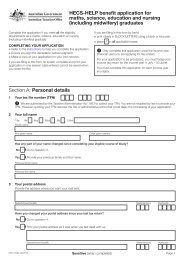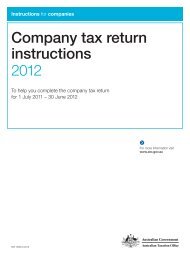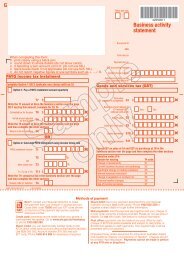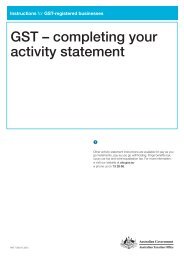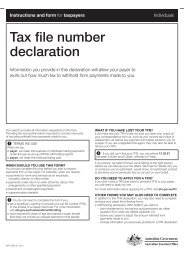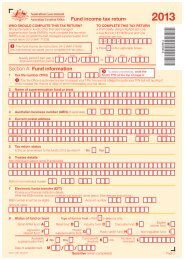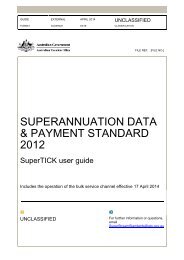Guide to depreciating assets 2013 - Australian Taxation Office
Guide to depreciating assets 2013 - Australian Taxation Office
Guide to depreciating assets 2013 - Australian Taxation Office
You also want an ePaper? Increase the reach of your titles
YUMPU automatically turns print PDFs into web optimized ePapers that Google loves.
CAPITAL EXPENDITUREDEDUCTIBLE UNDER THE UCAThe UCA maintains the pre 1 July 2001 treatment of somecapital expenditure and allows deductions for some capitalexpenditure that did not previously attract a deduction. Mos<strong>to</strong>f these deductions are only available if the expenditure doesnot form part of the cost of a <strong>depreciating</strong> asset.The following types of capital expenditure are deductibleunder the UCA:n landcare operations incurred by primary producers, otherlandholders and rural land irrigation water providers; seeLandcare operations belown electricity connections or phone lines incurred by primaryproducers and other landholders; see Electricityconnections and phone lines on page 29n environmental protection activities (EPA); see Environmentalprotection activities on the next pagen exploration and prospecting; see Mining and quarrying,and minerals transport on page 30n rehabilitation of mining and quarrying sites; see Mining andquarrying, and minerals transport on page 30n petroleum resource rent tax; see Mining and quarrying,and minerals transport on page 30n certain capital expenditure directly connected with a project;see Project pools on page 30n certain business related costs; see Business related costs– section 40-880 deductions on page 31Generally, <strong>to</strong> work out your deductions you need <strong>to</strong> reducethe expenditure by the amount of any GST input tax creditsyou are entitled <strong>to</strong> claim for the expenditure. Increasing ordecreasing adjustments that relate <strong>to</strong> the expenditure maybe allowed as a deduction or included in assessable income,respectively. Special rules apply <strong>to</strong> input tax credits onexpenditure allocated <strong>to</strong> a project pool; see Project poolson page 30.Small business entities that have chosen <strong>to</strong> use the simplifieddepreciation rules (except primary producers) may deductcapital expenditure under these UCA rules only if theexpenditure is not part of the cost of a <strong>depreciating</strong> asset.Primary producers that are using the simplified depreciationrules can choose <strong>to</strong> deduct certain <strong>depreciating</strong> <strong>assets</strong> underthe UCA rules; see Small business entities on page 32.Landcare operationsYou can claim a deduction in the year you incur capitalexpenditure on a landcare operation for land in Australia.Unless you are a rural land irrigation water provider,the deduction is available <strong>to</strong> the extent you use the landfor either:n a primary production business, orn in the case of rural land, carrying on a business for a taxablepurpose from the use of that land, except a business ofmining or quarrying.You may claim the deduction even if you are only a lessee ofthe land.The deduction for landcare operations was extended <strong>to</strong> ruralland irrigation water providers for certain expenditure they incuron or after 1 July 2004. A rural land irrigation water provider is anentity whose business is primarily and principally supplying water<strong>to</strong> entities for use in primary production businesses on land inAustralia or businesses (except mining or quarrying businesses)using rural land in Australia. The supply of water by the use ofa mo<strong>to</strong>r vehicle is excluded.If you are a rural land irrigation water provider, you can claima deduction for capital expenditure you incur on a landcareoperation for:n land in Australia that other entities (being entities suppliedwith water by you) use at the time for carrying on primaryproduction businesses, orn rural land in Australia that other entities (being entitiessupplied with water by you) use at the time for carrying onbusinesses for a taxable purpose from the use of that land(except a business of mining or quarrying).A rural land irrigation water provider’s deduction is reducedby a reasonable amount <strong>to</strong> reflect an entity’s use of the landfor a non-taxable purpose after the water provider incurredthe expenditure.A landcare operation is one of the following:1 erecting fences <strong>to</strong> separate different land classes inaccordance with an approved land management plan2 erecting fences primarily and principally <strong>to</strong> keep animalsout of areas affected by land degradation <strong>to</strong> prevent or limitfurther degradation and <strong>to</strong> help reclaim the areas3 constructing a levee or similar improvement4 constructing drainage works (other than the drainingof swamp or low-lying land) primarily and principally <strong>to</strong>control salinity or assist in drainage control5 an operation primarily and principally for eradicatingor exterminating animal pests from the land6 an operation primarily and principally for eradicating,exterminating or destroying plant growth detrimental<strong>to</strong> the land7 an operation primarily and principally for preventing orcombating land degradation other than by erecting fences8 an extension, alteration or addition <strong>to</strong> any of the <strong>assets</strong>described in the first four points above or an extensionof an operation described in the fifth <strong>to</strong> seventh points.The meaning of landcare operation was extended <strong>to</strong> apply<strong>to</strong> expenditure incurred on or after 1 July 2004 on:n a repair of a capital nature <strong>to</strong> an asset that is deductibleunder a landcare operationn constructing a structural improvement that is reasonablyincidental <strong>to</strong> levees or drainage works deductible undera landcare operationn a repair of a capital nature, or an alteration, addition orextension, <strong>to</strong> a structural improvement that is reasonablyincidental <strong>to</strong> levees (or similar improvements) or drainageworks deductible under a landcare operation.An example of a structural improvement that may bereasonably incidental <strong>to</strong> drainage works is a fence constructed<strong>to</strong> prevent lives<strong>to</strong>ck entering a drain that was constructed <strong>to</strong>control salinity.Expenditure incurred on or after 1 July 2004 on a repair of acapital nature, or a change <strong>to</strong> a <strong>depreciating</strong> asset may beeligible for the deduction for landcare operations under the28 a<strong>to</strong>.gov.au GUIDE TO DEPRECIATING ASSETS <strong>2013</strong>



